SUMMARY
- Network throttled millions of posts ahead of 2020 election, blocked “emerging narratives” from reaching a “virality threshold.”
- Censors boast on video of getting tech companies to ban entire categories of election speech under threat of “huge regulatory pressure.”
- Months before the 2020 election, censors systematically targeted all speech categories that could challenge a future “red mirage, blue shift” election scenario.
Last week, The Intercept published a set of leaks that drew broad interest in perhaps the most undercovered scandal inside the US government today: the Department of Homeland Security’s (DHS) quiet move to establish, for the first time in US history, an explicitly inward-facing domestic censorship bureau.What The Intercept glimpsed, however, is just the tip of a much larger iceberg.The size, scale and speed of DHS’s censorship operation are vastly larger have been reported. Based on our investigation, below are seven bottom-line figures summarizing the scope of censorship carried out by DHS speech control partners, as compiled from their own reports and videos:
- 22 Million tweets labeled “misinformation” on Twitter;
- 859 Million tweets collected in databases for “misinformation” analysis;
- 120 analysts monitoring social media “misinformation” in up to 20-hour shifts;
- 15 tech platforms monitored for “misinformation” often in real-time;
- <1 hour average response time between government partners and tech platforms;
- Dozens of “misinformation narratives” targeted for platform-wide throttling; and
- Hundreds of millions of individual Facebook posts, YouTube videos, TikToks, and tweets impacted, due to “misinformation” Terms of Service policy changes that DHS partners openly plotted and bragged tech companies would never have done without DHS partner insistence and “huge regulatory pressure” from government.
The citations above are from just the DHS censorship network’s impact on the 2020 election cycle alone. That was two years ago, when the narrative management machine referenced by The Intercept was first getting formed. Even the above figures, however, just scratch the surface of the full story.
While The Intercept rightly noted that DHS’s “truth cops“ now take on a range of other topics – such as Covid-19 and geopolitical opinions – it all started from, and grew out of, DHS’s speech control infrastructure set up to censor speech about elections.
That started with the 2020 election. But it continues, importantly, with the 2022 midterm elections, which are ongoing this week.
At Foundation for Freedom Online, for more than six months, we have been publishing and sharing research findings about a wide span of shocking components to DHS’s speech control operations. Our investigation has spurred multiple members of Congress to vow aggressive probes into DHS’s “government censorship by proxy.”
The whole story, however, has not all been published in one place. In this report, we seek to provide a comprehensive history and network map of DHS’s public-private censorship network, as told through a deep dive into its first mission — the censorship of the 2020 election.
Along the way, we will highlight the network’s role in censoring the ongoing 2022 midterm elections.
In the final section of this report, we will cover a particularly disturbing aspect of this story — DHS’s pre-censorship of speech that could “cast doubt” on a so-called “red mirage, blue shift” election scenario, months in advance of such an exact sequence playing out.
Background History & Cast Of Characters
In this background section, we will present a history and overview of the key players participating in DHS’s extended censorship network, with special attention to its formation in the run-up to the 2020 election.
This story has two main institutional sides: the government within DHS and the non-governmental side consisting of a web of like-minded private sector and civil society partners. Together, this network forms the DHS public-private censorship network that is the subject of this report.
The Government Side: Chris Krebs’s CISA
The key coordinating hub for the government side is an “obscure government agency” named CISA, which is tucked within DHS, and was created by act of Congress in November 2018, nominally to defend America against cybersecurity threats from hostile foreign actors (e.g., Russian hackers).
CISA’s longform name, the “Cybersecurity Infrastructure Security Agency” has none of the Orwellian overtones of the “Disinformation Governance Board”. CISA took great pains to cloak itself as just a simple, security-focused cybersecurity directorate. CISA’s founding director, Chris Krebs, was fond of telling audiences that CISA was just “The agency that cares so much about security, it’s in our name twice”.
CISA’s mission was supposed to be cyber security. Not cyber censorship.
But a funny thing happened on the way to the 2020 election.
First, on January 6, 2017, outgoing Obama Administration DHS Secretary Jeh Johnson designated “election infrastructure” as being “critical infrastructure” under the purview of DHS protection.
This designation, born out of unsubstantiated claims that Russia had just stolen, hacked or otherwise materially interfered with the 2016 election, tasked DHS with protecting election-related structure, such as polling places, voting machines and computer systems.
CISA’s Internet censorship power grew out of interpreting “critical infrastructure” beyond its hard physical meaning to apply to meta-physical concepts. By 2019, “foreign disinformation” on social media was increasingly framed as a “cyber threat” to election infrastructure.
Through this framing mechanism, CISA’s “cybersecurity” authority morphed into a “cybercensorship” authority. However, this move was initially limited to CISA only targeting “foreign disinformation”, through DHS’s Countering Foreign Influence Task Force.
But when the 2016 election-era “Russian interference” Special Prosecutor’s probe ended in July 2019 with former FBI Director Robert Mueller’s failure to find “collusion” between then-President Trump and outside Russians, DHS and CISA began to change their tunes.
The entire “countering Russian disinformation on social media” apparatus that had been constructed before July 2019 to censor, throttle and identify “foreign disinformation” was quietly, but entirely, pivoted to focus inward on “domestic disinformation.”
This “Foreign-To-Domestic Disinformation Switcheroo” on censorship was never widely conveyed beyond DHS doors out to the American people. It was plotted on DHS’s own livestreams and internal documents. DHS insiders’ collective justification, without uttering a peep about the switch’s revolutionary implications, was that “domestic disinformation” was now a greater “cyber threat to elections” than falsehoods flowing from foreign interference.
This meant that, henceforth, any US citizen posting what DHS considered “misinformation” online was suddenly conducting a cyber attack against US critical infrastructure. That was the legal framework under which DHS – and CISA particularly – drew their jurisdiction.
To illustrate this, we’ve put together a supercut of DHS censorship network partners switching from a “foreign” to a “domestic” predicate for censorship between the 2016 election and the 2020 election:
So CISA’s self-invented censorship powers against “foreign disinformation” went from being pointed outward against supposed Russian bot accounts to being pointed inwards at tens of millions of US citizens simply talking lawfully about their own elections.
The main character in the CISA side of this story is its then-director in 2020, Chris Krebs. After the 2020 election, CISA’s leadership baton was handed to current head Jen Easterly, covered below.
Since this is a story about government censorship and abuse of power, Chris Krebs’s public statements on censorship issues provide insight into the founding intent of the government censorship operation that first grew out of Krebs setting it up. Here are eight data points useful to bear in mind:
- Krebs said in April 2022 that the Hunter Biden laptop still looked like Russian disinformation and that Krebs didn’t care whether it was or wasn’t Russian disinformation; the important positive thing, he stressed, was that news media did not cover the laptop during the 2020 election cycle.
- Krebs, who administered the federal side of the 2020 election after DHS effectively nationalized election infrastructure on January 6, 2017, said that every lawyer who represented conservative clients on claims concerning 2020 election irregularities should be permanently disbarred and banned from legal practice for life.
- Krebs said he hopes conservative media outlets are bankrupted and forced to pay billions in damages in the ongoing lawsuit by Dominion Voting Systems. He stressed the same fate should apply to anyone in the news media who questioned US voting machines during the 2020 election, which he helped administer.
- Krebs said he personally canceled his DirecTV subscription in protest of conservative-leaning OANN having been allowed to have a platform on cable.
- Krebs said that the sitting President in 2020, Donald Trump, was a national security threat because he espoused domestic “disinformation.”
- Krebs said he feels equally passionate about the need to censor critics of government Covid-19 protocols as he does about censoring critics of government election administration issues.
- Krebs is so passionate about censorship he even called for a social media crackdown on the sale of humor tee-shirts that make jokes about Covid-19.
- Krebs has repeatedly said on record that “misinformation” is the single biggest threat to election security. Note that Kreb’s role in government was not supposed to be as arbiter of truth; he was supposed to be a cybersecurity expert from Microsoft. Yet US domestic citizen opinions on social media became, in Kreb’s estimate, the top “cyber” security threat facing the US, replacing foreign hacking and malware.
After leaving CISA, both of Krebs’s two new jobs in January 2021 were outgrowths of the very CISA censorship network Krebs established with outside partners while in government.
First, shortly before President Biden’s inauguration, Krebs started a private consulting firm with former Facebook executive Alex Stamos, simply called “Krebs Stamos Group.”
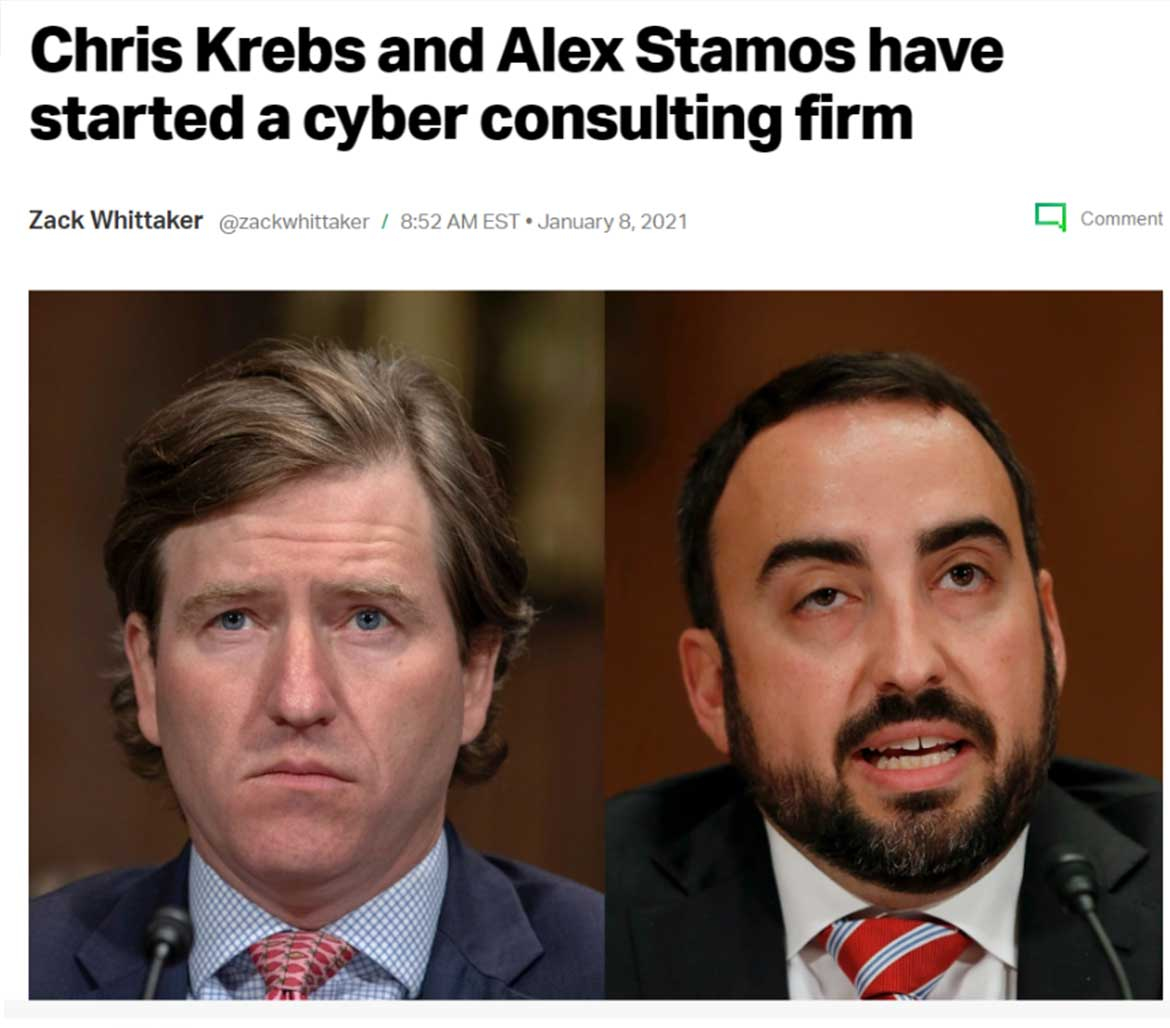
Stamos, covered extensively below, was perhaps the top figure overseeing the entire private sector side of the public-private censorship enterprise that Krebs and Stamos jointly built to censor populist political voices during the 2020 election.
It was Stamos who, according to his own group’s report, pitched the idea in July 2020 for DHS to even create a government censorship apparatus in the first place. Although, as we will cover, there is reason to believe such plans between Krebs and Stamos may have started considerably earlier than that reported date.
We will cover this Krebs-Stamos government-academia censorship relationship further below.
Krebs’s other role right after leaving CISA was becoming chair of the Aspen Institute’s “Commission on Information Disorder,” to galvanize a stronger “ whole-of-society” approach to censoring rumors and misinformation on the Internet.
Thus, Krebs – the original government censor – transitioned seamlessly through the revolving door of industry, into lucrative partnerships with private sector censorship professionals and prestigious civil society groups whose stated goal is decreasing the freedom of US citizen speech on the Internet.
Today, Krebs’s seat at the head of CISA is now occupied by Jen Easterly, a former military intelligence official who was deputy director of the National Security Agency (NSA) for counterterrorism. She appears to be taking her military intelligence experience squashing foreign terrorists from Tehran and using it to squash American populists on Twitter.
In October 2021, Easterly and Krebs held a 30-minute taped discussion for CISA’s “Cybersecurity Summit 2021: Continuity of Excellence” summit, in which they mutually agreed that Krebs’s construction of a “counter-misinformation” conglomerate with the private sector was among the top structures to preserve and expand at DHS going forward.
Easterly’s inheritance of Krebs’s censorship machine appears to be corroborated in the ongoing State Attorney General “big tech collusion” lawsuit versus the Biden Administration. There, the court recently ruled that Easterly can be deposed because of her “first-hand knowledge” of the censorship “nerve center” run out of CISA, her seeking “greater censorship… done by federal pressure on social media platforms”, and her reported statements that CISA’s “most critical infrastructure is a cognitive infrastructure.”
Before discussing the private sector side, it should be noted that the government apparatus at DHS is now larger and scattered beyond just CISA. As we have previously reported.
Let’s now move on to the private sector side of the equation. To whom did Chris Krebs and CISA outsource the task of mass social media censorship of the 2020 election? Who runs the private sector side and how is it all structured?
The Election Integrity Partnership
The main institutional character on the private sector side we will focus on in this story is a “counter-disinformation” collective called the Election Integrity Partnership (EIP). EIP is made up of four of the most powerful and politically well-connected social media monitoring and mass-reporting groups in the world. Their respective directors were all early industry pioneers in the rise of the censorship industry after the 2016 election.
The four entities comprising EIP are two universities, an influential foreign policy think tank, and a private social media analytics firm. They are, respectively:
- Stanford Internet Observatory;
- Washington University’s (UW) Center for an Informed Public;
- The Atlantic Council’s Digital Forensics Research Lab; and
- Graphika.
One common thread connecting these four entities is that each of their directors were involved in aggressively alleging (unsubstantiated) claims from January 2017 through early 2020 that Russian interference had helped Donald Trump win the 2016 election by using inauthentic bots and troll accounts on social media.
Each of the four entities comprising EIP is also deeply connected to the US military and foreign policy establishment. These four institutions further came into the 2020 election cycle with deep pre-existing connections to the major social media companies’ content moderation teams, having worked together on censorship issues since the field first began developing in 2017.
It is very helpful to understand EIP’s network and operations in depth, because it was through EIP that DHS built the infrastructure for its current role as government coordinator of takedowns and throttling of US citizen speech online.
Just to make this all perfectly clear up front, below is EIP leader Alex Stamos explaining the whole DHS-EIP partnership was set up to outsource censorship through EIP, “to try to fill the gap of the things that the government could not do themselves” because the government “lacked both kinda the funding and the legal authorizations”:
“Lack of legal authorizations” is a nice way of saying “illegal.” At best, legally dubious. So right there, you have Stamos directly saying the government couldn’t do it, so the government deputized Stamos’s politically like-minded outside network to do the dirty work.
Above, you may have heard Stamos euphemistically refer to EIP’s disinformation “research”, but it’s important to understand EIP did not just do “research”: they manually flagged posts and personally pressured for policy changes. That is active censorship, not passive research:
And below is Stamos being interviewed by The New York Times on August 26, 2020, right after EIP and DHS completed their planning sessions agreeing for EIP to do the censorship dirty work federal government insiders wanted done but weren’t allowed to do themselves. Stamos here describes how he had already lined up the tech companies to join the public-private censorship apparatus so EIP could quickly go straight from scanning posts to banning them:
Full quote from clip above, for reference:
“We have reached out and we have had two-way conversations with all of the major platforms. Right, so we’ve had really good conversations with all of the major platforms. Facebook, Twitter, Google, Reddit… so that’s been good. So I think our goal is that if we’re able to find disinformation, we’ll be able to report it quickly, and then collaborate with them on taking it down. There’s a good precedent for this, which is that all four of these organizations have worked on research projects side by side with tech platforms.” (Emphasis added)
So right there with those two clips above alone, you have Krebs’s partner Stamos describing how DHS and EIP will collectively get around the presumed illegality of direct government censorship by outsourcing it to EIP, and then EIP pre-loading a multi-platform censorship network directly with the tech platforms — all to squash a target set of US voters talking about their own elections.
Note that Stamos brags “there is a good precedent” that this plot to censor domestic speech will work because “all four” of the EIP organizations worked with the tech platforms to take down foreign speech previously.
It’s as if they see no difference between a social media user being a US citizen or being a hostile foreign nation-state when it comes to speech about US elections.
It is important to understand (and we will cover the numbers below) that this is way bigger than just censoring one story, like the Hunter Biden laptop, for “Russian disinformation.” This is taking the entire digital speech throttling apparatus built to stop “Russian interference” after the 2016 election, and turning it lock stock and barrel against US citizens talking about US elections, for every election forevermore.
The Intercept revealed a “Facebook portal” the government can access to flag content, but what’s already in use by DHS and EIP is much, much worse.
Below, you’ll see DHS, EIP and social media companies all on a shared real-time chat app (Jira Service Desk) to coordinate speech takedowns all as a single, seamless unit. Below are two sample screenshots EIP provided in their own report for the example of their work to censor posts sharing the 2020 election #Sharpiegate narrative, which concerned alleged voting irregularities related to the use of overbleed markers.
Note that “EI-ISAC” in this chat below is DHS’s “cyber mission control”, who the rest of the world thought was just a 24/7 cybersecurity center having nothing to do with coordinating the censorship of trending narratives on Twitter.
Censorship collusion screenshot #1:
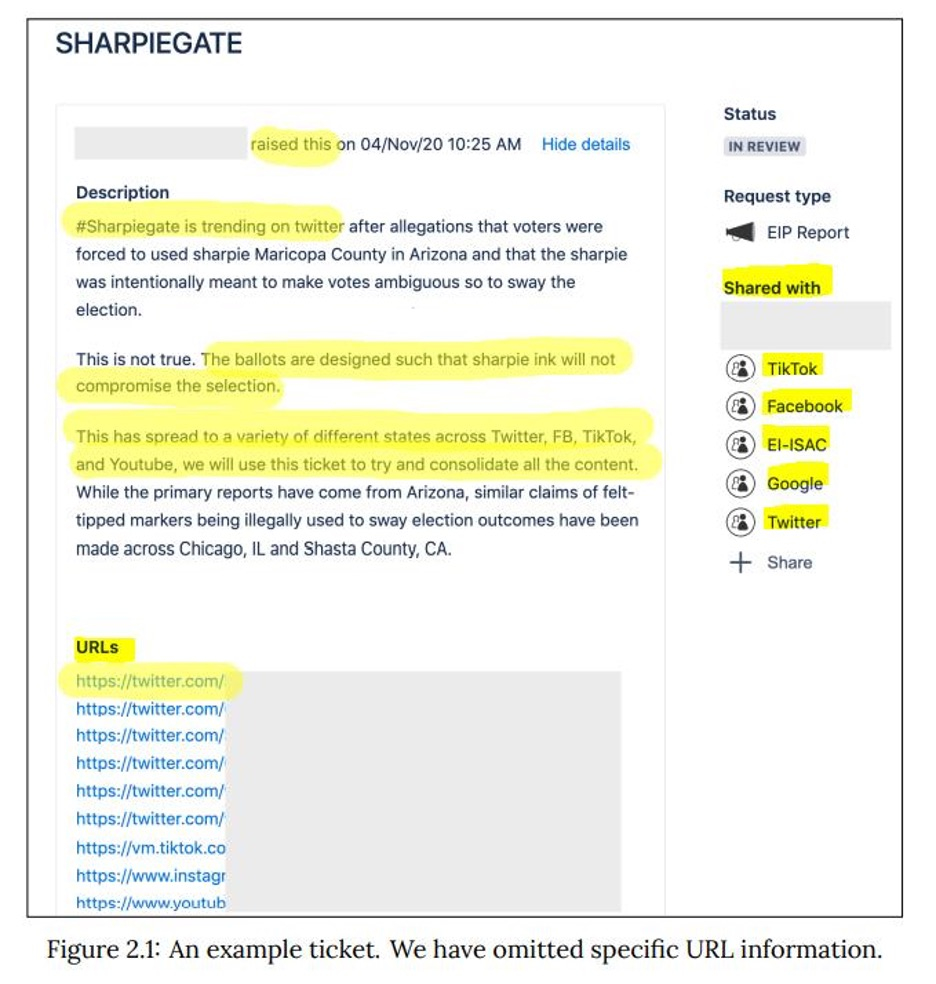
Censorship collusion screenshot #2:
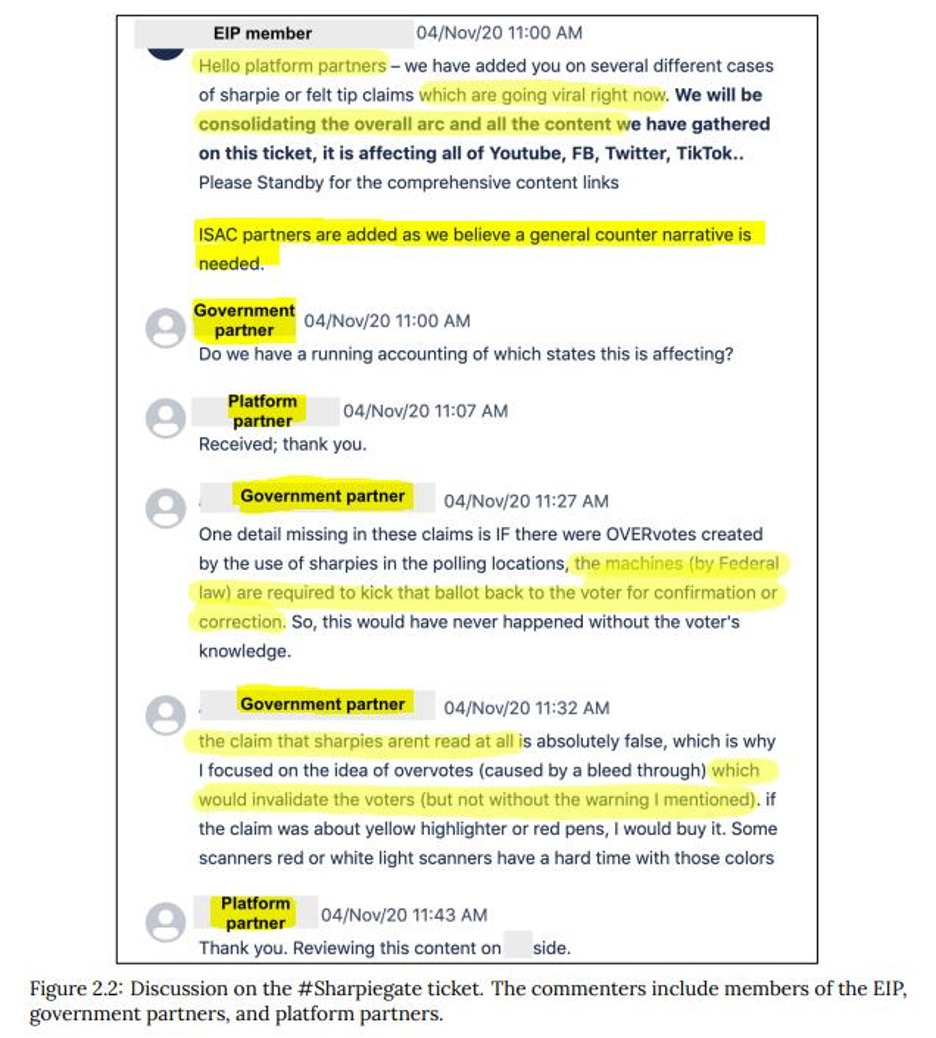
Notice that in the above conversation, the redacted “Government partner” didn’t even fully dispel the narrative tagged as “misinformation”. They actually appear somewhat to confirm citizen concerns. “Government partner” at 11:27 AM and 11:32 AM says sharpies may invalidate votes, but “the machines (by Federal law) are required to kick that ballot back” and that could “invalidate” votes after giving a warning. So if warnings were not given or officials didn’t follow federal law, votes indeed may have been impacted by the markers.
FBI officials are supposed to follow federal law when filling out FISA warrant applications to spy on people. Sometimes the law isn’t followed. Should there be a government censorship bureau to pre-ban all social media narratives that suggest someone might not be following federal law?
The point is: we don’t know, and even the censors didn’t know the ground truth with certainty. And yet the entire narrative was censored off the Internet anyway, in real-time, in shady back rooms, in cahoots with DHS, and unbeknownst to the entire rest of the country participating in election discourse.
EIP, in their own report, shows they throttled 822,477 tweets alone on the #Sharpiegate topic. And that’s just Twitter — not including YouTube, Facebook, TikTok, and other platforms named in the tickets above. That means millions of posts were impacted.
And EIP had over 600 tickets like this just for the 2020 election alone. (And then they went and helped the government censor Covid)
Also, why are the names of the government partners on EIP’s tickets redacted? What’s with the secrecy? Don’t they work for us?
We refer to Stamos’s EIP network in this report statically as just “EIP” because our focus is election censorship, but it is important to understand that the specific network around EIP plays an extraordinary role in government censorship well beyond just in the election context.
For example, government censorship roles and EIP censorship jobs are a revolving door. For example:
- CISA chief Chris Krebs founded a two-man firm with EIP Stanford Alex Stamos;
- CISA chief Krebs’s top CISA deputy, Matt Masterson, joined EIP Stanford;
- EIP Stanford’s Alex Stamos is on CISA’s “Cyber Hygiene” advisor subcommittee;
- EIP Stanford’s Renee DiResta gives lectures at CISA disinformation summits;
- EIP UW’s Kate Starbird heads CISA’s “disinformation” advisor subcommittee;
- EIP network affiliate Maria Barsallo Lynch was just hired by CISA to help censor the 2024 election
And that’s just a short list.
DHS and EIP aren’t just a revolving door of government censorship personnel. They’re also a revolving door of government censorship priorities.
For example, while EIP started out censoring elections for Chris Kreb’s CISA, after the 2020 election, EIP changed its name and re-branded as an entity called the “Virality Project” (VP). VP did the exact same government censorship job EIP did, except censoring Covid-19 instead of censoring elections. And now the tight-knit network is back calling themselves EIP again, censoring the 2022 midterm elections this week.
To make this perfectly clear, below is a formal CISA conference lecture in 2021 given by Alex Stamos’s top EIP Stanford lieutenant Renee DiResta, who explains this part of this revolving door to government partners at DHS:
As we will cover in a future report, VP ended up censoring, with its government partners, 66 unique social media narratives going viral online concerning Covid during the 2021 calendar year. Not 66 posts. 66 entire narratives. That had the effect of impacting millions of posts and potentially altering the entire political trajectory of the American citizenry’s response to the Covid pandemic.
Let’s now turn to the specific four institutions and myriad leaders comprising EIP, because the public statements and professional history of the censors is a useful lens from which to understand the intent of the censorship.
Stanford Internet Observatory:
The Stanford Internet Observatory (“SIO” or “Stanford disinfo lab”) is an academic center set up in June 2019 for the purposes of promoting Internet censorship policies and for doing real-time social media narrative monitoring of targeted political and social causes.
During the 2020 election, SIO had 50 “misinformation” analysts at the university assigned to monitor conservative social media posts after SIO began its partnership with CISA.
Before receiving a $3 million government grant from the Biden Administration in 2021 after censoring the Biden Administration’s political opposition in 2020, SIO was originally funded by private foundations such as Craig Newmark Philanthropies, the Omidyar Network, and the Charles Koch Foundation.
SIO is run by its director Alex Stamos and its research manager Renee DiResta.
Stamos is the former Chief Security Officer of Facebook (now Meta) who led Facebook’s response to alleged “Russian disinformation” after the 2016 election. He left the social media giant in 2018 after reportedly clashing with top brass.
Stamos’s quite explicit goal is to end the era of the traditional free and open Internet and move toward a controlled “cable news network” model where socially impactful views must first be authorized by a gatekeeper:
In case there’s any ambiguity as to Stamos’s worldview on censorship, in the clip below from June 2021, Stamos states quite plainly that the target for censorship is simply ordinary people with large follower accounts who have the ability to impact public narratives:
As noted above, Stamos has a close personal and business relationship with Chris Krebs and the broader DHS-CISA “disinformation” network. In December 2019, Krebs, then head of CISA, traveled from Washington, DC to California (when Stamos’s Stanford lab was just three months old) for a personal roundtable with Stamos and his new “misinformation” team at Stanford (they specifically discussed “election security” for the 2020 election, which includes “misinformation”).
When Chris Krebs was terminated from CISA after the 2020 election, Chris Krebs immediately started a two-man business consultancy firm with Stamos in January 2021 called Krebs-Stamos Group. Krebs the government side, Stamos the private sector side.
In the run-up to the 2020 election, while Chris Krebs was running CISA, Stamos was a frequent panel speaker on CISA “disinformation” panels.
In December 2021, with Jen Easterly at CISA’s helm, Stamos was directly made a member of CISA’s private sector advisory committee, where he has regular meetings with CISA brass.
Stamos’s top lieutenant at the Stanford disinfo lab is research manager Renee DiResta.
DiResta, as noted above, gave a 15 minute keynote lecture at a taxpayer-funded October 2021 CISA summit, in which DiResta described how EIP and DHS worked together to censor social media narratives at scale before, during and after the 2020 election,
The prominent role Renee DiResta plays in EIP – a government-partnered Internet censorship consortium – is particularly worrisome and disturbing.
Before DiResta became research manager at the Stanford disinfo lab, she was research director for a now-notorious, scandal-laden and disgraced political hatchet firm known as New Knowledge LLC.
In December 2018, the New York Times exposed that DiResta’s Democrat donor-funded small cybersecurity firm, New Knowledge, had clandestinely created thousands of fake “Russian bots” (user accounts generated with a virtual private network (VPN) to simulate a Russian IP address) on Twitter and Facebook then mass subscribed those fake “Russian bots” to opposition Republican Senate candidate Roy Moore’s campaign.
DiResta did this – or at least the small firm where she was a director did this — in the heat of the Nov. 2017 Alabama special election, which substantially decided the party control of the US Senate. It was a race in which Moore narrowly lost, and for whose loss New Knowledge – in its own report — took credit.
At the time, mainstream news genuinely thought Roy Moore was being backed by Russians. But it was just DiResta’s professional disinformation firm interfering in the election.
See, e.g., Fox News’s coverage here:

The scandal was so outrageous that DiResta’s future co-partner in the EIP censorship coalition, the Atlantic Council, called out how egregiously disastrous and morally repugnant the depths of her company’s deception was in effectively rigging the Senate vote with fake Russian bots:
The inauthentic Russian bot activity DiResta’s firm generated was forensically detected by Facebook, who banned the CEO of DiResta’s firm from Facebook, as well as four other DiResta associates.
According to the New York Times, DiResta’s firm had bragged in an internal report after Moore lost the election: “We orchestrated an elaborate ‘false flag’ operation that planted the idea that the Moore campaign was amplified on social media by a Russian botnet.”
That report (available in part here) appears to show DiResta’s company avidly tracking mainstream media pickup of their plot to deploy fake Russian bots then paint their political opponent as a Russian stooge.
Meanwhile, at the time in Nov. 2017, DiResta had the chutzpah to appear on live TV as an expert on “social media disinformation” — opining on disinformation in the very Senate race her firm was secretly conducting “black hat” false flag cyber operations on behind the scenes. The whole time on TV, she never disclosed a word about the most heinous social media election disinformation campaign ever caught red-handed in the modern era — her own.
Yet despite what is perhaps the most dubious pockmark possible for a self-professed expert on “Russian disinformation”, DiResta would go on to be a lead author of the Democrat-led Senate Intelligence Report on “Russian disinformation in the 2016 election” in November 2019.
DiResta’s discredited firm also told the Senate Intelligence Committee that a “Russian troll farm” had secretly supported Jill Stein’s Green Party candidacy in 2016 with Facebook meme pages. This claim had the effect of delegitimizing Jill Stein’s vote tally, which CNN suggested was responsible for Hillary Clinton’s failure to defeat Donald Trump in the 2016 election.
In a heated January 2019 exchange, Jill Stein called out CNN’s uncritical amplification of New Knowledge “Russian Facebook meme” allegations. This exchange is also useful to demonstrate how this censorship consortium targets the populist left as well as the populist right:
Stamos and DiResta are both members of the Council on Foreign Relations, which recently argued the “free and open Internet model” is no longer working and the US should adopt a more semi-closed and speech restrictive posture.
The role of the Senate Intelligence Committee (who tapped DiResta to write its “disinformation” analysis) in the DHS-partnered censorship network is particularly disconcerting.
Then-head of the Senate Intelligence Committee, Mark Warner (D-VA), had a panel discussion with Chris Krebs in October 2019 at a DHS-CISA conference in DC. In that panel, Senator Warner boasted to Chris Krebs that he had just had dinner with Facebook CEO Mark Zuckerberg the night before the CISA panel. For that dinner, Senator Warner claimed he assembled fellow Senate Intelligence Committee to effectively threaten Mark Zuckerberg with heavy-handed regulation if Zuckerberg didn’t do what was expected of him — especially on “content moderation” (read: censorship) on the platform:
Some other notables about the influence and reach of the Stanford disinfo lab is that Stanford University was the site of where President Obama gave his “social media misinformation is a threat to democracy” speech in April 2022.
It was Alex Stamos’s department at Stanford who hosted President Obama for that speech. The introduction to President Obama was given by Stamos’s boss at Stanford and the head of the Stanford Cyber Policy Center, Michael McFaul.
Again as a reflection of the partisan bias of the personnel DHS outsourced social media censorship to, McFaul was a loud, proud and driving force behind the Congressional impeachment of President Trump in 2019.
On September 4, 2020, while McFaul was tweeting that Trump could no longer lead because he had lost the intelligence community and the military, McFaul’s faculty lieutenants Alex Stamos and Renee DiResta had just been deputized the day before, by Chris Krebs’s CISA, to censor millions of Trump’s supporters off the Internet ahead of the election.
Facts like this help explain, as we shall see later, how every single “repeat misinformation spreader” account EIP reported for throttling in the 2020 election cycle was a right-wing populist account.
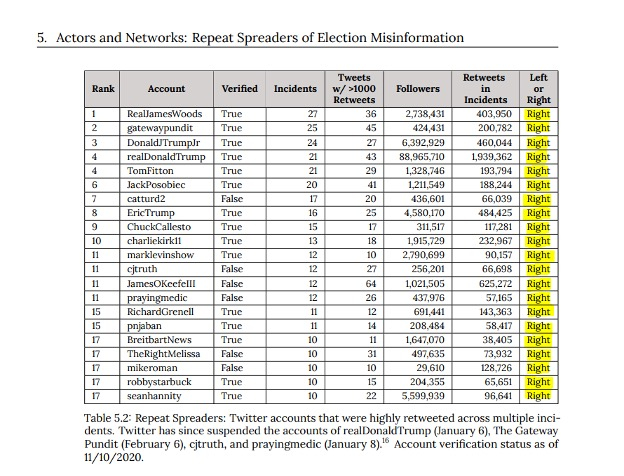
EIP targeted the same populists for takedowns on essentially every platform.
University of Washington (UW) Center For An Informed Public
After the Stanford disinfo lab, the second entity in the EIP censorship consortium is the UW disinfo lab. But the UW lab is essentially an outgrowth of the Stanford network. That is because the UW disinfo lab is anchored by Stanford computer science graduate and Stanford visiting professor, the longtime social media censorship proponent and research analyst Kate Starbird.
It is instructive to see Starbird’s standard presentation for how she helped DHS censor the 2020 election, and who her top targets were:
Starbird, who describes herself in her Twitter bio as an “Army brat”, specializes in “crisis informatics and online rumors”. Her PhD thesis in 2012 was titled “Crowdwork, Crisis and Convergence: How the Connected Crowd Organizes Information during Mass Disruption Events.”
Her online lectures before the Trump presidency detail her work to help the US government detect and halt the spread of rumors spreading online that undermine public faith in official government narratives during crisis events. This chiefly entails creating network maps of social media users discussing “Alternative Narratives of Crisis Events”, including conspiratorial narratives in which the general public speculates about “powerful people controlling world events.”
Her censorship work has been funded by government grants since 2013.
After the twin populist events in 2016 of Brexit and the election of Donald Trump, Starbird’s work switched suddenly to focus on right-wing populists, who in her research represented a collective “disinformation” threat around the world. Her targeting included Trump supporters in the US, Jair Bolsonaro supporters in Brazil, Marine Le Pen supporters in France, and more.
Albeit to a lesser extent, Starbird also targeted left-wing populists of the anti-imperialist type, mostly associated with Bernie Sanders in the US and Jeremy Corbin in the UK, during the periods such figures were surging politically as well. In the below lecture from October 2019, for example, Starbird posits disinformation as coming from the populist right when social media voices support Donald Trump, and disinformation as coming from the populist left when social media voices oppose US war in Syria.
Kate Starbird’s UW disinfo lab’s most recent activity in 2022, per their website, is “auditing” Google search engine results to pressure Google to scrap all listings of websites regarded as challenging 2020-era election processes (such as mass mail-in ballots and early voting drop boxes). You can find a copy of that report here.
Recently, Starbird celebrated the tech platforms conforming to EIP’s insistence that social media posts about the 2022 elections be censorable under a low bar of simply “misleading”, rather than actual “misinformation”, as this avoids the “fumbling around” job of censors having to prove the thing they want banned is actually false.
Like Alex Stamos (head of Stanford disinfo lab), Kate Starbird, as head of the UW disinfo lab, was directly made a member of the US government’s formal advisory committee for CISA in December 2021. Indeed, Kate Starbird now heads CISA’s new 2022 subcommittee on “Protecting Critical Infrastructure from Misinformation & Disinformation.”
The trick behind that subcommittee name is that virtually every topic of significance can now be deemed “critical infrastructure” as a pretext to censor discussion of it. What began as “election infrastructure” as the genesis of CISA’s legal jurisdiction in January 2017 has now mission-creeped all the way to “cognitive infrastructure,” cited by current CISA head Jen Easterly.
Note that Starbird sits on CISA’s disinformation advisory panel directly with Vijaya Gadde, the recently fired top lawyer at Twitter who famously promoted censorship of the hashtag “#LearnToCode” on Joe Rogan’s podcast in March 2019, led the internal Twitter decision to ban President Trump’s Twitter account in January 2021, and vociferously opposed Elon Musk’s proposal to roll back Twitter censorship policies.
At CISA’s June 2022 advisory committee meeting, Kate Starbird recommended that “CISA should invest in external research to assess the impact of MDM [Misinformation, Disinformation, Malinformation] threats.”
Starbird herself stands to gain from such government investment. But such a government payday for censorship work would not be her first time. Indeed, the Biden Administration provided Kate Starbird’s UW disinfo lab with a $3 million government grant (jointly with Stanford) just months after Starbird’s lab helped censor the Biden Administration’s political adversary during the 2020 election. Now it appears she is using her platform to ask the US government for more taxpayer dollars to flood into the industry that targets the taxpayers.
The Atlantic Council’s DFR Lab
After the Stanford disinfo lab and the UW disinfo lab, the third partner in EIP is the Atlantic Council, and specifically the Atlantic Council’s London-based Digital Forensics Research (DFR) lab.
At first, it may seem strange for the US government, via CISA, to outsource censorship of US citizens during a US election to an entity not even based in the US. But the rules are different for the DFR lab, which is perhaps the most established and influential full-time censorship institution in the world today.
A full exposition of this subject is beyond the scope of this report, but we will cover some highlights.
Technically speaking, the Atlantic Council is classified as a think tank, widely said to represent NATO’s collective foreign policy interests. It is therefore a “transatlantic” institution, rather than one strictly concerned with the interests of US citizens.
However, the Atlantic Council represents a powerful faction of the US foreign policy establishment, in the diplomacy, defense and intelligence spheres. It has seven (7) former CIA directors currently serving on its own board of directors (Michael Hayden, James Woolsey, Leon Panetta, David Petraeus, Michael Morrell, William Webster and Robert Gates).
Former DHS Secretary Michael Chertoff — Chris Krebs’s old boss when he worked for DHS under the Bush Administration — is also an Atlantic Council director, as are several other major DHS figures. Chertoff was the interim head and review authority for DHS’s Disinformation Governance Board after it was initially put on “pause” for review. It was the Atlantic Council’s “Forward Defense” / “Future Of DHS” blueprint report in September 2020 that formally posited DHS transition from a counterterrorism focus to a focus on “non-kinetic” threats such as social media misinformation. Incidentally, September 2020 is exactly when CISA formally began its censorship partnership with EIP.
In October 2020, the Atlantic Council hosted a livestream discussion of this new proposed domestic censorship role for DHS with three former DHS Secretaries (and that discussion has some remarkable moments).
Virtually every senior figure at CISA and across the other EIP entities involved in censoring the 2020 election has directly participated in Atlantic Council events, tying the networks together personally and professionally.
Chris Krebs gave a talk to the Atlantic Council titled “Protecting The US Election” in October 2018, just one month before Krebs was made the founding director of the newly created CISA. That same month before he got the CISA job, Krebs made a video to DisinfoPortal explaining why disinformation is important to him.
DisinfoPortal had just been created in June 2018 by the Atlantic Council, working directly with the National Endowment for Democracy (NED) and 23 participating organizations for censoring election narratives ahead of 2019’s European elections. Krebs then migrated into CISA to administer the cyber aspects of the US 2020 election.
After Krebs was made CISA director, he then gave a keynote speech to the Atlantic Council in April 2019, again focused on elections. Krebs returned again after the 2020 election.
So too it is with the senior leaders of the Stanford disinfo lab and the UW disinfo lab. Stanford’s Alex Stamos and Renee DiResta gave a joint presentation to the Atlantic Council in June 2021. UW’s Kate Starbird was a panelist on Internet censorship policy discussions at the Atlantic Council first in October 2018 and then again in June 2019.
The Atlantic Council’s DFR Lab was one of the first institutions focused full-time on advancing mass social media censorship. Since Ukraine had been the Atlantic Council’s marquee country of focus in 2014, this think tank sat uniquely at the crossroads of US and NATO foreign policy decisions, Russia-Ukraine tensions, and the evolving role of social media narratives in determining candidate popularity in democratic elections.
The Atlantic Council seized the moment after the 2016 US election to massively upscale its DFR Lab into the most prominent “counter-disinformation” organization in the foreign policy sphere.
The figure who leads the DFR Lab is Graham Brookie. Brookie previously served in the Obama White House as part of the National Security Council. Brookie previously held a number of government roles at the intersection of national security, foreign policy and homeland security.
In May 2018, Facebook designated the Atlantic Council an official partner in “countering disinformation” worldwide.
As we have previously reported, the Atlantic Council played a key role in training journalists to contextualize disfavored politicians as trafficking in “disinformation” to provide a predicate for removing their voices — and therefore their domestic influence — from social media.
Below, for example, you will see two “disinformation” experts from the DFR lab, Ben Nimmo (now team leader of Global Threat Intelligence at Facebook) and Andy Carvin, at an Atlantic Council conference in June 2019. They are training a roomful of vetted international journalists on how to spot “disinformation” in tweets by then-President Donald Trump and in ads promoting Brexit. Senior journalists were encouraged to hold up placards reading “Bullsh*t” as Trump tweets and Brexit slogans played across the screen:
If this is a difficult video for American audiences to stomach, just remember you paid for it. The Atlantic Council receives US taxpayer funding from the State Department, USAID, the National Endowment for Democracy, the Defense Department, the US Marines, the US Air Force, the US Navy, and numerous other federal agencies detailed here.
Other sources of funding for the Atlantic Council include a coterie of energy companies and weapons manufacturers.
Perhaps most concerning among the Atlantic Council’s funders in the censorship context has been the scandal-plagued Ukrainian gas company, Burisma. Burisma is the company that was under criminal investigation for corrupt practices in Ukraine. The company paid a handsome salary to Hunter Biden on its board as Biden allies allegedly lobbied State Department officials on Burisma’s behalf.
The Atlantic Council both formerly partnered with (under a mutual cooperation agreement in January 2017) and was funded by Burisma.
So a disinformation flagger funded by the very company that gave monthly payoffs to the son of then-canditate Biden was selected as DHS’s social media censorship partner for the 2020 election.
Given that Biden was reputed to be in charge of Ukraine policy while serving as Vice President during the Obama Presidency, it is perhaps unsurprising that Biden also delivered keynote speeches at Atlantic Council events, and was personally honored with a Distinguished Leadership Award from them in 2011.
And while it is beyond the scope of this report, in 2018, Biden co-founded the Transatlantic Commission on Election Integrity (TCEI), which formally partnered with the Atlantic Council in 2019 to use “rapid response” counter-disinformation teams to scrub targeted voices off of Ukrainian social media. Incredibly, EIP, of which the Atlantic Council is a part, bills itself as a “rapid response” counter-misinformation team to do the same to US social media as was done to Ukrainian social media — but partnered with DHS instead of Biden’s group, TCEI.
Graphika
The fourth and final official partner in EIP, in addition to Stanford, UW and the DFR disinfo labs, is a private network analysis firm called Graphika.
Graphika was yet another contributor to Senate Intelligence Committee reports in December 2018 alleging Russia undermined the integrity of the 2016 election. In its report, Graphika claimed to have uncovered “unusually rich detail the scope of Russia’s interference not only in the 2016 U.S. presidential election but also in our day-to-day democratic dialogue.”
As Slate reported:
The Senate Intelligence Committee has just released two new reports on Russian disinformation, revealing in unusually rich detail the scope of Russia’s interference not only in the 2016 U.S. presidential election but also in our day-to-day democratic dialogue since. One report was prepared by New Knowledge and the other by the University of Oxford and Graphika. Each report’s specific findings are well worth close study by anyone concerned with foreign interference in U.S. elections and our broader democratic processes; so is an excellent summary offered by New Knowledge’s co-founder Renée DiResta.
Note again the other report besides Graphika’s in that December 2018 Senate Intelligence Committee release was from Stanford Internet Observatory research manager Renee DiResta’s former social media “black ops” political hatchet firm, New Knowledge — who got busted creating artificial Russian bot accounts to discredit the Republican Senate candidate in the heat of a tightly contested race.
Graphika is in many ways an extension of the Atlantic Council disinformation network described above. Recall the June 2019 Atlantic Council DFR lab video above where DFR lab Senior Fellow Ben Nimmo trained independent journalists to identify banal Trump tweets and Brexit slogans as “disinformation.” Well, that same Ben Nimmo, two months after the clip above, would be hired by Graphika to reprise his same censorship role there, this time as Graphika’s Director of Investigations.
To show the total absence of technical rigor in Atlantic Council and Graphika arbitrary designations of populist social media accounts as “Russian bots and trolls”, the “Ian56” episode is particularly instructive.
In March 2018, Ben Nimmo publicly named a popular anonymous Twitter account, “Ian56”, as being a Russian disinformation bot account because “Ian56” posted frequently online and consistently expressed left-of-center populist anti-war views with respect to NATO military operations in Syria. Because of Ben Nimmo’s say-so, “Ian56” was reported to the UK government.
Sky News then messaged the account, and amazingly, “Ian56” appeared on TV, in the flesh, to repudiate Ben Nimmo’s “Russian bot claim” by showing his face. Ian56 was simply a passionate British bloke who got in the way of the censorship industry’s narrative control agenda — and he was labeled a “bot” to get rid of him:
Note, again, the above citizen was targeted for censorship by a private sector partner of the government, and was targeted expressly because he criticized government actions online.
This is, effectively, government censorship of social media achieved through the use of a private sector cut-out.
This cut-out relationship is made all the more plain by the fact that Graphika has historically been funded by government grants from DARPA and from the Defense Department’s Minerva Initiative (which effectively focuses on psychological warfare and great power competition).
In 2021, the year after Graphika helped censor the 2020 election for the Biden Administration, Graphika was rewarded with nearly $5 million in government grants from the Pentagon – all to facilitate more censorship work.
What is Graphika up to now? Well, just this week, Graphika’s proprietary analysis determined, based on a small sample of cartoons on fringe websites, that “suspected Russian actors are engaged in a renewed effort” to interfere in the 2022 midterm elections, creating a Russiagate narrative spread far and wide by the New York Times just days ahead of election day.
2020 Election: Who DHS Censored, How & Why
The analysis above reveals that every single person, without exception, involved in the creation and administration of DHS’s election censorship apparatus, were all on the same side of the 2020 election: staunchly establishmentarian, and passionately crusading against the right-wing populist energies associated with Donald Trump.
Not letting the other side into the room where speech gets censored is like not letting the other side into the room where votes get counted. It lets partisans get away with anything.
And that is exactly what happened in the 2020 election. The chart below shows EIP’s top 21 “repeat information spreaders” targeted for throttling during the 2020 election cycle. You’ll notice a pattern in the right-hand column:
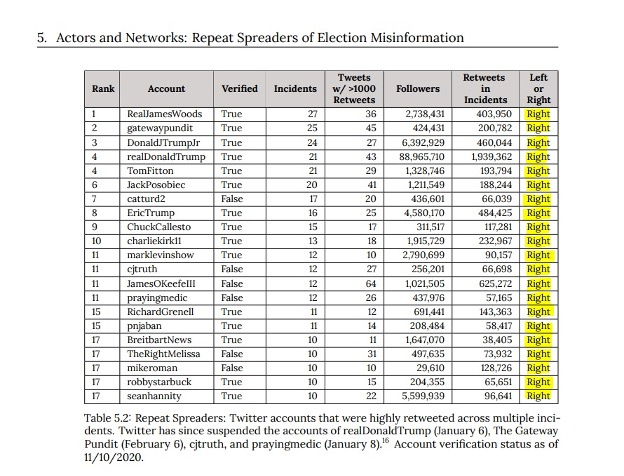
This means 100% of all targets of “repeat spreader misinformation” by DHS and EIP were all in the same political party category monolithically opposed by DHS and EIP insiders.
And the censors were flippant and arrogant about their partisanry, to boot. Below, EIP, as the federal government’s deputized election disinformation flagger, specifically termed one candidate in the election “The Social Media Death Star” of disinformation:
It’s bad enough that all of the government censorship was hyper-targeted against one specific side. But it gets much more serious once you understand the scale of censorship.
The Intercept‘s report last week cited “nearly 4,800 flagged items” by EIP during the 2020 election cycle, but that understates the volume of posts impacted by at least three orders of magnitude. The “nearly 4,800” only refers to “unique original URLs” listed in EIP’s ticketing system. It does not include narrative-level throttling and bulk collection censorship.
The scale of impact here is not in the low thousands. It’s in at least the tens of millions.
EIP, in its own report, say they classified 22 million tweets (21,897,364 individual posts, to be precise) as each comprising unique “misinformation incidents” during the four-month period between August 15, 2020 and December 12, 2020.
To get this 22 million “misinformation” number, EIP created a bucket of 859 million tweets discussing “misinformation narratives”, and then applied a crude set of subjective inferences to conclude that 22 million tweets out of that 859 million total could be confidently classified as endorsing a banned “misinformation narrative.”
EIP uses a system where each “misinformation incident” is classified as part of a specific larger “misinformation narrative”. EIP then turns around and pressures social media representatives to censor entire narratives at scale by using the network maps and narrative analysis that EIP compiles shares with social media companies. Below are just a few of the dozens of narratives EIP targeted for throttling wholesale:
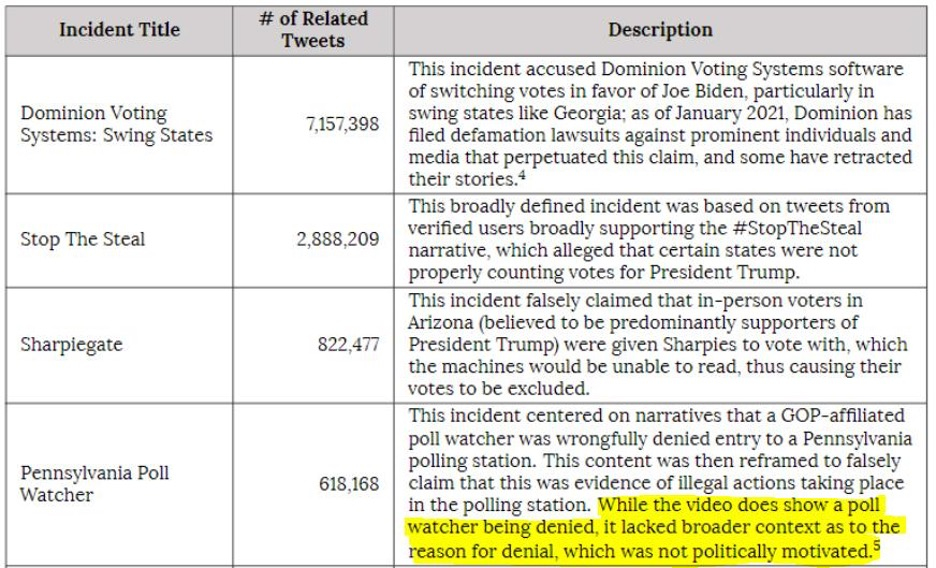
As just one example of the myriad tricks EIP used to shoehorn in censorship of election discussions, in highlights above, you’ll see that EIP labeled the entire narrative surrounding a Pennsylvania poll worker’s denial of entry into a polling station as being “misinformation.” Their reasoning does not even deny the basic facts of the denial of entry, but rather makes a subjective determination about the political motivations behind the narrative.
On that basis alone, they targeted over 600,000 tweets pertaining to that poll worker event for censorship.
Below is an EIP graph of the “speech tactics” EIP reported as misinformation. Those 600,000 tweets above would be flagged under the “partisan but it’s not” ticket type below. Note also how subjective the other categories are: “exaggerate issue”, “misleading stats” and “out of context” are all subjectively assessed by censors who openly deride one half of the electorate as supporting a “Death Star Of Disinformation”
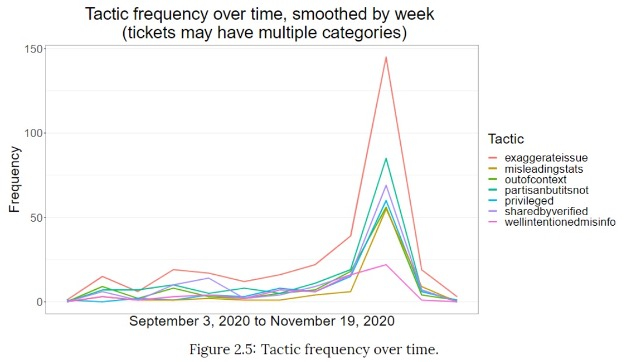
But to pull off total mass censorship of just one side of the election and still pretend the whole thing was not outrageous, partisan, or stunningly corrupt, EIP and DHS insiders came up with a much bigger trick.
See, when EIP talks in presentations and materials about its targets for “misinformation”, they always begin by stating they were going after speech that was “fraud”. And then they mention speech that constitutes “procedural interference” (telling people to vote at the wrong location) and “participation interference” (voter suppression).
But this is a trick. The vast, overwhelming, and statistically virtually the only speech category that EIP really cared about, and really censored systematically, was their fourth category: “delegitimization.”
Delegitimization was a brand new censorship category EIP and DHS came up with, and pressured social media companies to implement, beginning in June 2020, five months before the election.
It was through this trick that EIP created 72% of its censorship tickets and targeted over 99% of the posts throttled by narrative during the 2020 election.
This is because the EIP-rigged definition of “delegitimization” – defined to mean any speech that “casts doubt” on any kind of election process, outcome or integrity issues — made all conservative and populist criticism of the administration of the election pre-banned at the narrative level, five months in advance of Election Day.
The result was that a user merely posting “incidents” of election issues was still committing a Terms of Service violation because “incidents” had the effect of “casting doubt”, and thus even factual reporting was effectively banned altogether.
Why did virtually all of the tech companies change their Terms of Service to ban such an obscure concept as “delegitimization”? It turns out, government pressure and EIP insistence played an apparently massive role there as well.
In this clip (embedded earlier above), EIP members openly brag how their pressure tactics got tech companies to create this new censorship category. They discuss how they exploited tech companies’ fear of “massive regulatory pressure” and bad press if they didn’t play ball censoring populist speech in the categories of speech bans they lobbied for.
The gall to mass censor “delegitimization”, coming from this crowd, is truly something to behold. The entire EIP network consisted of professional delegitimizers of the 2016 election who dedicated their entire careers to promoting the (unsubstantiated) theory that Russia had stolen the 2016 election.
Alex Stamos, Renee DiResta, Kate Starbird, the entire Graphika team and the DFR lab were all personally the foremost tips of the spears that created a narrative that the sitting United States President from 2016-2020 was functionally “illegitimate” because of unfounded rumors about Russiagate that turned out later not to be true.
If “delegitimizing election processes or outcomes” were a principle EIP upheld faithfully, all US citizen speech about Russiagate, or “Russian tampering or interference” with US elections, would be massed banned at the narrative level too, because such claims “casts doubt” on voter confidence in US election integrity, or voter perceptions that their vote counts.
In fact, if the “delegitimization” principle were upheld, EIP members would have to ban themselves from the Internet. As noted above, just this week, Graphika published a pitiful analysis of just a small handful of ridiculous cartoons on fringe US websites, which Graphika concluded was the cartoon handiwork of “suspected Russians” potentially trying to interfere with the midterm elections. That wholly unsubstantiated Graphika analysis, couched in the word “suspected”, generated an equally unsubstantiated Russiagate narrative in the New York Times just days ahead of midterm election day, citing Graphika’s rumors.
This process of unsubstantiated rumors that may “cast doubt” on perception of a fair election, getting a giant media megaphone and being amplified before being verified, is exactly what EIP claims its counter-disinformation enterprise is organized to stop.
And now we come to perhaps the most disturbing section of this report:
Pre-Censoring All Speech That Could “Cast Doubt” On The Legitimacy Of An Obscure Possible Future Scenario Five Months Away
The deeper you look into EIP’s data and DHS meetings, the clearer it becomes that the entire DHS outsourced censorship structure was set up in June 2020 to pre-ban speech that could energize or mobilize opposition to a future “red mirage, blue shift” scenario five months away on Election Day.
For those unfamiliar, “red mirage, blue shift” refers to the scenario where a GOP candidate appears to win on election day, but then due to the counting the following day of mass mail-in ballots, a DNC candidate appears to suddenly take the lead and win (pictured below):
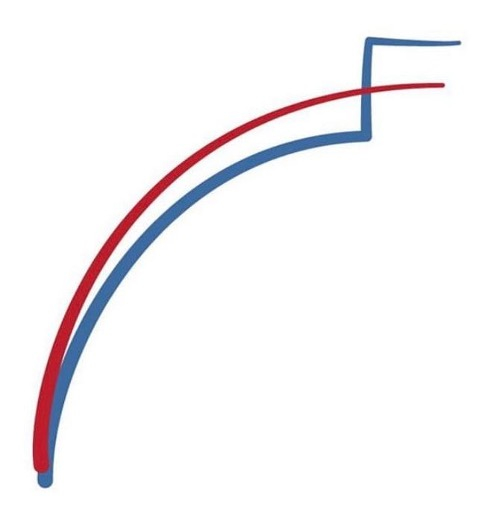
Here note that EIP specifically sought out that exact image above to censor from social media. For example, EIP details how they repeatedly got TikTok to ban posts such posts because they “delegitimize the election results”:
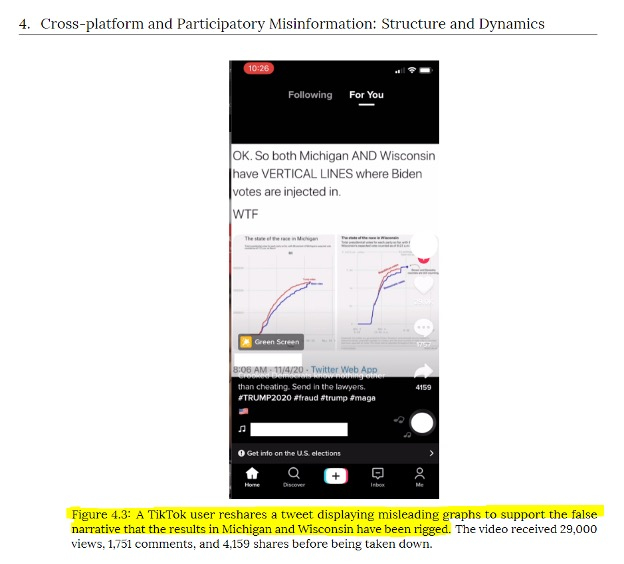
Well, as it turns out, the censorship category of “delegitimization” – which again, produced 99% of all EIP censorship impact, as measured by incidents from narrative-level data — had a very specific set of targets in mind.
As you can see in EIP’s report graph below, from day 1 of EIP’s tracking data until election day, the censorship focus was always and consistently foremost targeted at speech casting doubt on mail-in ballots. And then, on election day, after the mail-in ballots were in, EIP’s focus flipped to censoring speech about ballot counting during the long delay in winners being announced:
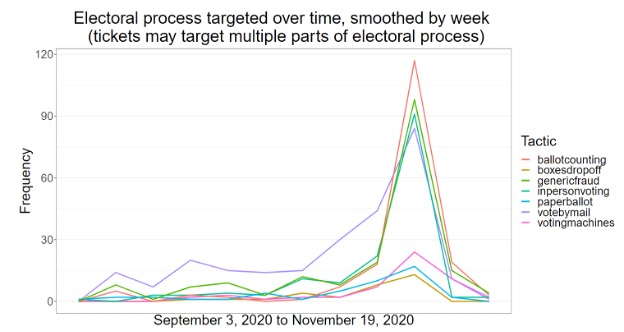
That means DHS’s censorship operation specifically sought out, as its top censorship priority five months in advance, the exact discourse underpinning opposition to a controversial “red mirage, blue shift” sequence.
Bear in mind, CISA was put in charge of election security for elections. So this means the same obscure DHS subagency tasked with election security also gained the power to censor any questions about election security.
And Chris Krebs himself said the domestic disinformation threat started in summer 2020 and was chiefly about criticism of mail-in ballots, which again lines up right with when the DHS-EIP partnership started.
Notably, EIP’s highest number of tickets at the state level to censor ‘misinformation’ related to Pennsylvania mail-in ballots. As it turned out, Pennsylvania became the most hotly contested state on the mail-in ballot issue, with 3 million mail-in ballots to count after Election Day in 2020.
🧵Today, we examined another false rumor based on a misinterpretation of data surrounding voter verification in Pennsylvania. The rumor emerged due to misleading framing of data provided by PA’s Department of State.🧵
— Election Integrity Partnership (@EI_Partnership) November 1, 2022
In the 2022 midterm elections, EIP is tightly monitoring and working to censor “discussions surrounding the delays in counting ballots” being ‘framed as fraud’:
Looking at the cumulative plot, discussions surrounding the delays in counting ballots have only become more common and more viral in recent days and will likely continue to spread on Twitter and elsewhere over the next week: pic.twitter.com/xznHZ9GjKN
— Election Integrity Partnership (@EI_Partnership) November 5, 2022
And they are censoring, as in 2020, with a special focus on Pennsylvania.
To understand the AI technology EIP uses to track and monitor citizen speech, the below clip provides a useful lens:
On top of this troubling set of motivations and techniques, consider EIP’s stated objectives of their censorship (which CISA head Chris Krebs endorsed as well). In the report graphic highlighted below, you will see EIP’s stated goals are to stop targeted social media narratives before hit the “virality threshold”, so they never generate three “IRL” (in real life) outcomes: protests, legal challenges, and mainstream news coverage:
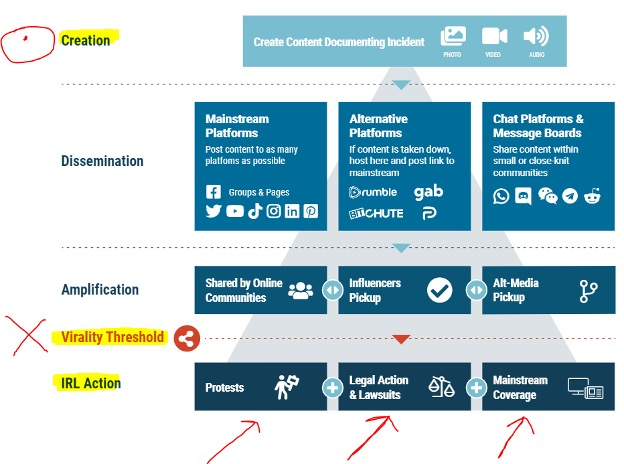
This is sacred First Amendment stuff sought out for chilling by DHS-deputized censors.
EIP is well aware that pre-censoring US citizen debate about mail-in ballots five months before an election has the impact of devastating the ability of concerned citizens to pressure their state representatives to take legal action on changing voting procedures.
And we know EIP knows this because in the Covid censorship context, they lamented that their censorship efforts weren’t severe enough to stop citizens in Ohio from passing laws curtailing vaccine mandates there.
So they know pre-censoring speech that “casts doubt” on mail-in ballots means pre-squelching the political energies necessary to organize pressure to obtain voting alternatives.
Now we know the “why” and the “how” DHS pre-censored criticism of a future “red mirage, blue shift” scenario. Does the “when” line up?
First, in light of the premeditated pressure EIP Stanford’s Alex Stamos applied to tech companies to censor mail-in ballot skepticism after meeting with DHS, it is telling that the exact same day Facebook announced it would begin censoring mail-in ballot ‘misinformation’ was the exact same day DHS and EIP formally began their partnership: September 3, 2020.
This gave the censorship partnership an immediate first-order target: mail-in ballot discussion on Facebook. Then the very next week Twitter bowed to EIP’s insistence and changed its Terms of Service to throttle mail-in ballot narratives as well.
Second, to hear Alex Stamos tell the story of EIP, this multi-million tweet-censoring enterprise with 120 staffers all started with interns that Stamos sent to Krebs at CISA in the summer of 2020. And everyone just cared about “election security”, without a special focus on mail-in ballots:
But this is not the same origin story highlighted by other EIP members.
For example, Kate Starbird’s standard presentation always singles out and centers this below June 22, 2020 tweet from then-President Trump, casting doubt on the legitimacy of mail-in ballots:
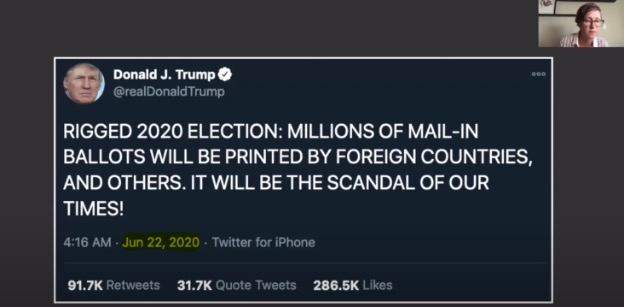
June 22, 2020. And when did EIP have its first discussion?
Wouldn’t you know, it’s June 23, 2020. The very next day.
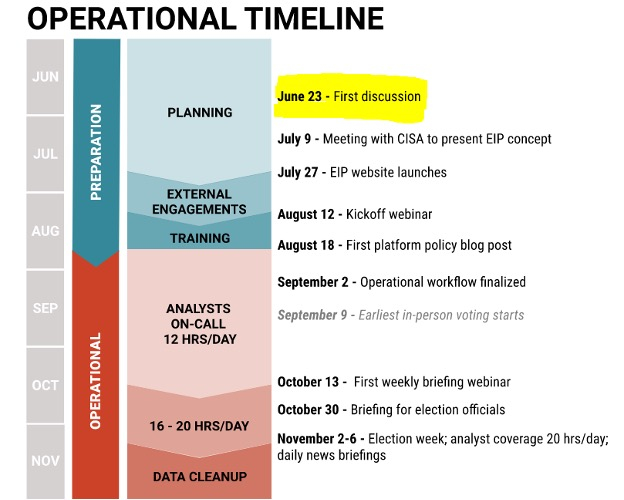
What this government censorship operation looks like, then, is not some general “election security” blanket concern to protect all Americans from “misinformation.” It looks like in June 2020, a partisan, powerfully connected political network, panicked that Americans might push back on the use of mail-in ballots months in the future, and got together with government and private sector insiders to stop that pushback from happening by unleashing censorship of the Internet on a scale never before seen in American history.
At Foundation for Freedom Online, we do not opine on the specific election integrity issues or voting processes mentioned in this report. Our focus is squarely on matters concerning threats to online freedom.
We humbly suggest, however, that America can have a democracy where citizens can speak in the light, or a technocracy where censors control from the dark.
We cannot have both.

Michael Benz is the Executive Director of the Foundation for Freedom Online. Previously, Mr. Benz served as Deputy Assistant Secretary for International Communications and Information Technology at the U.S. Department of State. Follow him on Twitter @FFO_Freedom.




